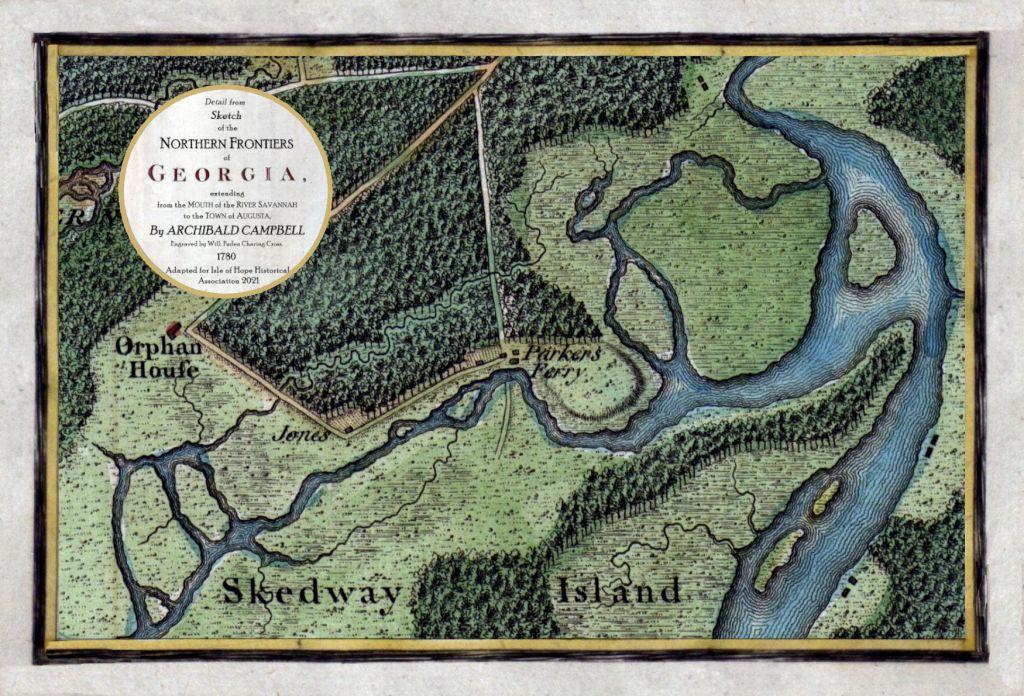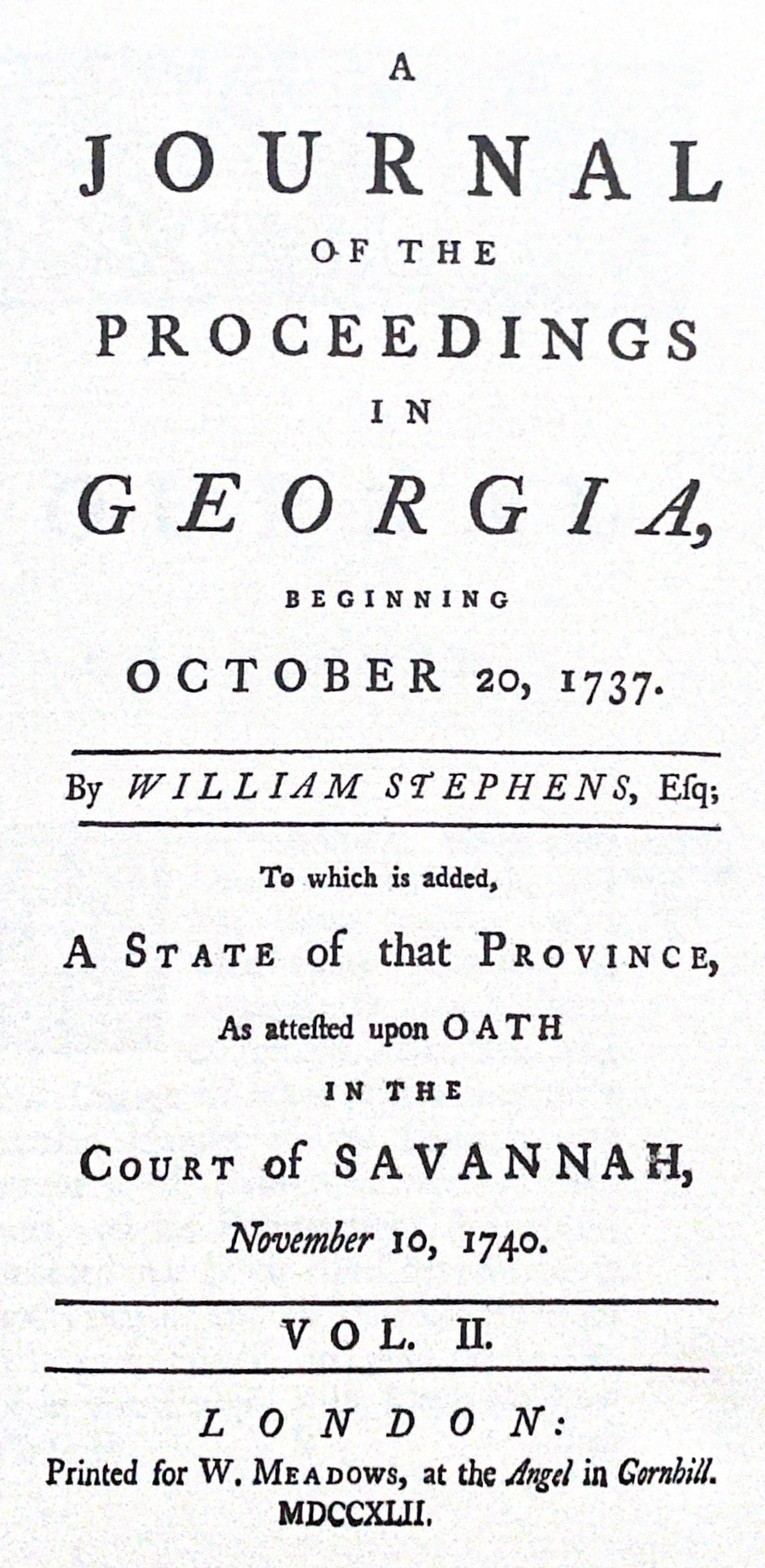Sixteen years after the founding of Isle of Hope, cartographer William DeBrahm identified the settlements of “Cap: Jones” and “Henry Parker Esq: President” on his topographic map of the coast of Georgia. He did not identify Isle of Hope itself, only these two individual settlements. This was the first time any landmark on Isle of Hope had been identified on a map. This map is a magnified view of the small portion of DeBrahm’s map that relates to Isle of Hope. DeBrahm’s entire map, entitled, “A Map of Savannah River Beginning at Stone-Bluff, or Nexttobethel, which Continueth to the Sea, also the Four Sounds Savannah, Hossabaw, and St. Katherines and their Islands”, depicts hundreds of miles, first along the Atlantic Ocean and then up the Savannah River border with South Carolina. This is one of DeBrahm’s earliest maps in colonial America. He would later become Surveyor General of Georgia and South Carolina and is considered one of...
Historic Buildings

EXPLORE ISLE OF HOPE’S GEOGRAPHY
Beginning in 1752, less than twenty years after its first settlement, Isle of Hope landmarks and the island itself began to appear in maps of the day. Some were surveys of large expanses of land, such as maps of the State of Georgia, with Isle of Hope being a minor feature and sometimes merely designated with a dot. Others were lot-level maps of Isle of Hope land with great detail about specific properties. Between these extremes were maps that depicted the entire island or its major portions.
Each map reveals important information, including property owners and property lines, locations of roads, railroads, and ferries, as well as topography and growth patterns. The selection below includes some of the best examples of Isle of Hope maps. Several of the maps are never-before-seen compilations of other maps. Others are magnified detail of the Isle of Hope portions of much larger maps. We will continue to add old and new maps of the island for you to zoom and explore
1780 1st Map Identifying “Isle of Hope”
This is detail from the earliest map that identifies Isle of Hope. The larger map, by renowned cartographer Joseph Frederick Wallet DesBarres (1722-1824), shows the Atlantic Coast from St. Catherine’s Island in the south to the May River in the north. DesBarres created The Atlantic Neptune, a four-volume atlas that is considered the most important collection of maps of North America in the eighteenth century. The detail relating to Isle of Hope shows three different settlements along an unlabelled waterway that is the Skidaway River. These three settlements correspond with the three original settlement on Isle of Hope dating back to 1736, forty-four years before the map was created. The first settlement shown in the south of Isle of Hope corresponds to the land grant for the Jones property at Wormsloe. The second settlement in the middle corresponds to the original property of John Fallowfield, who left the colony in 1742. His...
1780 Revolutionary War Isle of Hope
This beautiful, hand-colored map shows Isle of Hope at the time of the Revolutionary War. In 1778, the British under Lieutenant Colonel Archibald Campbell invaded Georgia and captured Savannah and Augusta. In 1780, Campbell created a much larger, uncolored map based upon his military campaign along the Georgia coast and up the Savannah River. His complete map provides information about the siege of Savannah as well as other towns, plantations, and roads in colonial Georgia his troops encountered during the British invasion. Isle of Hope played no role in Campbell's Revolutionary War military operations. The part of Campbell’s map relating to Isle of Hope contains far less detail than other areas of his map where his troops were active. Isle of Hope is depicted as a heavily wooded, sparsely populated island. There are only two settlements shown on the island, one for Jones and one for Parker, two of the families who first settled...
1810 “Wamberly”
This checkerboard map by Isidore Stouf shows the first subdivision of Wymberley and the beginnings of the Bluff Drive properties as we know them today. From 1736 until 1810, the first three generations after Isle of Hope was settled, the 500 acres of the Wimberly Plantation was a single, undivided piece of property. In 1810, when this map was created, Wimberley Plantation was owned by one woman, Mrs. Sarah Jones Glen, the granddaughter of one of Isle of Hope’s original settlers, Noble Jones. Noble Jones received the land directly from King George. Noble left the land to his son, Noble Wimberly Jones. Noble Wimberly Jones gave the 500 acres intact to his daughter Sarah. Sarah had a plantation house, kitchen, and gardens at Wimberly Plantation when she died in 1804. She was a widow, having outlived her husband, John Glen, who had been Savannah’s mayor and the first Justice of the Supreme Court of Georgia. Sarah and John had thirteen...
1824 “Ila of Hope”
This map is based on a tracing of the resurvey map by John McKinnon as described in its transcribed map legend. The colored boundary lines noted in the legend have been added from the original map. As the legend states, the map documents the two-part subdivision of the Parker tract comprising the north end of the island, circa 1800, but also includes the property boundaries of William Parker’s heirs, not mentioned in the legend. This copy also includes later boundary lines of the Thomas Henderson property (in red) and other details not on the original map. (Special Thanks to Karl Schuler)
1846 Map of Northern Isle of Hope
This map is an 1881 tracing of an 1846 map which showed the division of Dr. William Parker’s large land holdings on northern Isle of Hope. Dr. Parker was the grandson of Henry and Ann Parker, the original settlers of the northern 500 acres of Isle of Hope. William Parker died a childless widower in 1838 and left portions of his property to his nieces and nephews, Alexander and James Maxwell, William Parker Bowen, Mary Amelia and Ann Mathews White, and Robert Guerard, many of whom are identified on this map. William Parker also willed 10 acres of land on the Bluff to Christ Church, which are shown on the map and labeled the “Church Lots”. Not surprisingly, present day Parkersburg Road is labelled on the map as “Road to Dr. Parker’s”. The map shows far more of Isle of Hope than Dr. Parker ever owned, particularly in the Wymberley area. The “Wymberley Lots”, the group of the five-acre lots along the Bluff which were divided under the...
1865 Civil War Isle of Hope
This composite of two maps produced at the end of the Civil War shows most of the Confederate earthworks constructed during the war, as well as the bridge and causeways connecting Isle of Hope with Skidaway Island, via Long Island. The Confederate causeway across Jones Narrows has been added from other sources. The locations of Parkersburg and Wimberly, as labeled, are incorrect. The map also illustrates the large Confederate batteries at Thunderbolt and Beaulieu to the north and south of Isle of Hope, the locations of observation towers and telegraph lines, and the locations of Confederate salt works in the vicinity. (Special Thanks to Karl Schuler)
1875 1st Map Showing Railroad
This map gives a glimpse of Isle of Hope just after the Civil War. Savannah mapmaker Charles Platen worked several years to create a topographical map of all of Chatham County, relying on 37 original deeds, maps, and surveys of portions of the county. He then spent seven months in Philadelphia with a printmaker ensuring that the produced lithographic maps, some nearly 4 feet by 6 feet in size, were perfectly printed. In December of 1876, The Savannah Morning News proclaimed Platen’s work “the handsomest lithographic map in America” and stated, “As a work of art, it is a magnificent specimen, and as an accurate and complete map of the county, its equal has never been seen, and its value cannot be overestimated.” Platen’s map is the first map to show a railroad to Isle of Hope. The Savannah, Skidaway & Seaboard Railroad had reached the island in July of 1869, six years before. Strangely, on Platen’s map, the name of the railroad...
Isle of Hope and Vicinity circa 1890
This map is condensed from the topographic survey map of Chatham County completed by county engineer, Richard Blandford. It documents in detail topographic features such as dams, canals and earthworks, including vestiges of Civil War earthworks. Details also include locations of roads, buildings, cemeteries and other features that in some cases are otherwise undocumented on maps. Numbered coordinates on the 1000-foot grid mark distances south, east and west from the old City Exchange, the current location of City Hall. (Special Thanks to Karl Schuler)
1895 The Grimball Point Property of Cyrenius Hall
This map relates to 116 acres on northern Isle of Hope owned by Cyrenius Hall, Isle of Hope’s greatest artist, whose portrait of Chief Joseph of the Nez Perce Indian tribe hangs in the National Portrait Gallery and was featured on a 6 cent stamp. The map was prepared in January of 1895 by Chatham County Engineer E. J. Thomas and is entitled, “A Plan of Twenty Lots at Isle of Hope Surveyed for Cyrenius Hall, Esq.” Today the area on the map would be generally bounded by Grimball Point Road on the north and west and Hopecrest Avenue on the south. The map shows one chapter in the story of the subdivision and development of the Grimball Point area, a story that begins with the Parker family in the earlies days of colonial Isle of Hope. Cyrenius’ 116 acres were part of the original 500 acres that Henry Parker settled in 1736 as one of Isle of Hope’s original settlers. Henry did not receive a land grant for the property and never owned...
1901 Roads and Streetcar Lines From Savannah to Isle of Hope
In 1901, the Savannah Morning News commissioned civil engineer Percy Sugden to prepare a map of Chatham County. The purpose of the map was to spotlight the many advantages Chatham County presented to prospective business owners, such as its large port and waterways, its extensive railroad system and terminals, and its many roadways and streetcar circuits. The entire Chatham County map was published with an accompanying article in a two page spread in the April 4,1901 edition of the Savannah Morning News. The map above is a portion of that larger Chatham County map and focuses on Isle of Hope's connections to downtown Savannah. Two streetcar lines are shown running from Savannah to Isle of Hope. The Savannah, Thunderbolt, and Isle of Hope Electrical Railway and The City and Suburban Electrical Railway each ran separate rail lines from midtown Savannah out to the Sandfly streetcar station. Once at Sandfly, a single rail line ran...
1908 Great Savannah Race Course
In 1908, the Savannah Automobile Club, with several Isle of Hope representatives on its Executive Committee, hosted the annual championship races of the Automobile Club of America. The Grand Prize race, whose course is shown by this map, was truly an international competition with German, French, Italian and American entries among the twenty teams. One of the reasons Savannah was selected as the race site was its splendid roads and beautiful scenery, especially along the circuit of roads in its waterfront suburbs, including Isle of Hope. These roads formed the 25-mile course that the racers would lap sixteen times with a winning average speed of 65 mph. The course included straightaways where speeds reached 100 mph. However, the stretch at Isle of Hope, from Skidaway Road to Parkersburg Road to Bluff Drive to LaRoache Avenue, had several sharp turns that greatly reduced the speed to 37 mph. One race car of team Italia ran off the...
1908 Wormsloe
Civil engineer W.O.D. Rockwell’s map provides a detailed plan of the Wormsloe plantation and surrounding areas at the outset of the twentieth century. Landmarks at Wormsloe depicted include the long entrance avenue, the old colonial fort “Fort Wymberly,” and the confederate battery “Battery Wymberly,” as well as hammocks, pine woods, open fields and dams. The location of the Jones family mansion and outbuildings are shown as dots at the end of a road and marked, “Wormsloe.” Shown outside the boundaries of the plantation are Long Island in its entirety and just a bit of Skidaway Island with two bridges, the “long bridge” and the “short bridge,” connecting Isle of Hope to Skidaway Island via Long Island. Portions of undeveloped, pre-James Richmond Wymberly are shown. Present day Parkersburg Road is labelled “To Parkersville.” Also shown outside of Wormsloe boundaries is the route of the Savannah Electric Railway electric streetcar...
1916 Barbee’s and Bluff Buildings
This 1916 Sanborn Fire Insurance Company map provides amazing detail of Isle of Hope's Bluff area from just over a hundred years ago. Beginning in 1867, Sanborn created maps for thousands of cities across the country to assist with property insurance. The maps included not only typical map features, such as streets and property boundaries, but also included the size, shape, and site of all structures, both residential and commercial. Sanborn had created earlier maps for Savannah in 1884, 1888, and 1898. The 1916 Savannah map was the first Sanborn map to include Isle of Hope. This map focuses on the area in the center of the island along the Skidaway River, which at that time was dominated by the businesses and buildings of Alexander Barbee, the Terrapin King. Barbee had been operating at Isle of Hope now for over twenty years with a series of partners, first with George Willett, then with J.H. Bandy, and finally with his son,...
1930 Tourist Map from Downtown Savannah to Wormsloe Gardens
Illustrated in 1930 by Charleston cartographer Augustine Thomas Smythe Stoney, this map provides a pictorial annotated guide to two scenic drives from Savannah’s urban center to Wormsloe Plantation on Isle of Hope. The early 20th century was marked by the rise in popularity and affordability of the automobile, which created opportunities for many Savannahians to explore beyond their immediate surroundings. Coupled with the expansion of the Good Roads Movement, a new swath of paved concrete roads in Savannah enabled city dwellers and tourists to enjoy a pleasurable drive out to the newly opened Wormsloe Gardens. Stoney’s whimsical map, entitled “How to Get to Wormsloe Near Savannah, Ga.”, was the perfect road map to encourage this adventure. Minding Stoney’s written instructions to “Follow the ARROWS”, the map provides two illustrated routes to navigate from City Hall in bustling downtown Savannah to Wormsloe in the lush...
1942 WW II Aerial Photograph
This wartime photograph, labeled “SECRET”, provides a spy plane’s view of Isle of Hope. While there is no residential development in Wymberley or Paxton Heights in 1942, there is cleared land on north Isle of Hope that is the start of a new subdivision. Isle of Hope’s Skidaway River waterfront is lined with docks and looks very active. It does not appear to be a “No Wake Zone” in the 1940s. Barbee’s operations are clearly visible with the diving tower reaching skyward. The Skidaway Road and LaRoche Avenue causeways can be seen cutting through the surrounding marsh as well as the streetcar causeway reaching from Central Avenue towards Norwood. Roads and clearings on Wormsloe among its densely wooded forests. The rest of Isle of Hope is also densely wooded. Away from the Bluff, the greatest areas of clearing are on northern Isle of Hope. That will change in the coming years. (Special Thanks to Forrest Willoughby)
1947 “Wymberley” Map
This map shows James Richmond’s vision for his subdivision "Wymberley" and was included as a centerfold in the sales brochure for the development. The layout of the subdivision as built differs slightly from this early map. Note that only three streets are named at the is time, Noble Glen Drive, Avenue of Pines, and Richmond Drive. Richmond would later name the other streets after the prior owners of the Wymberley land (Col. Estill Avenue and Flinn Drive), his wife (Dorothy Drive), and his daughters (Nancy Place and Diana Drive). A few notable homes are illustrated along with a few jumping fish and some seagulls.

MINE OUR HISTORY
Sometimes you just have to go back to the original documents, or at least as close as you can get. This collection of historic documents relating to Isle of Hope includes primary source materials, such as original land grants, colonial journal entries, personal letters, and censuses, as well as selected summaries and articles about those documents.

















